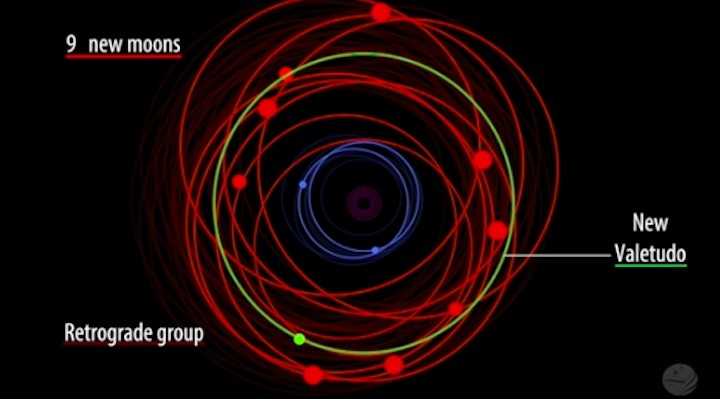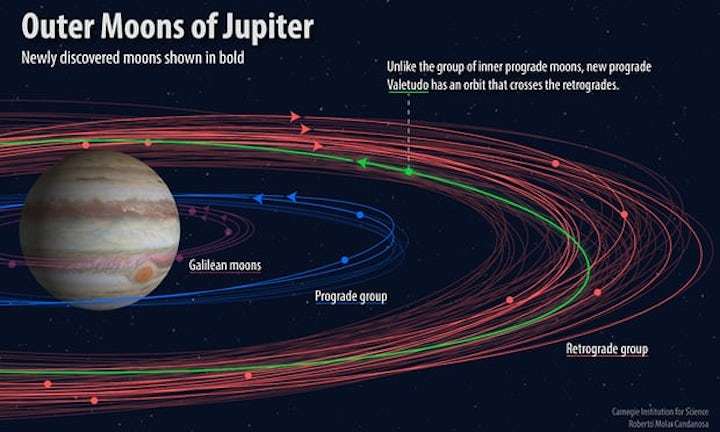18.07.2018

Our solar system's oldest and biggest planet, Jupiter, has many moons. And astronomers have just announced the discovery of a dozen more.
On Tuesday, the International Astronomical Union’s Minor Planet Center published the orbits for 12 newfound Jovian moons — bringing Jupiter's total to 79 moons, said Scott Sheppard, a scientist at the Carnegie Institution for Science in D.C.
Sheppard did not set out to detect new moons. His team at Carnegie, along with collaborators at the University of Hawaii and Northern Arizona University, was hunting for objects far beyond Pluto.
“We're looking for new possible planets and dwarf planets in our solar system, just seeing what is out there,” Sheppard said.
But cosmic serendipity placed the moons in front of their telescope. During their survey in March 2017, the astronomers realized that Jupiter had moved into their field of view. The Blanco four-meter telescope, at the Cerro Tololo Inter-American Observatory in Chile, is equipped with a camera able to spot very faint objects. This proved to be quite helpful, as the unknown moons around Jupiter are small and dim.
“We were able to go a little bit fainter than anyone has been able to go in the past,” Sheppard said, “and that's why we were able to find these new moons.”
Jupiter's moons range in size from shrimpy satellites to whopping space hulks. Galileo discovered the first four of Jupiter's moons, all huge, in 1610. The largest Galilean moon, Ganymede, is bigger than the planet Mercury. Those moons orbit close to Jupiter and travel in the same direction as the planet spins.
The moons Sheppard spied are farther-flung and tiny, each no more than two miles in diameter. One moon detected by Sheppard and his colleagues is the smallest Jovian moon ever discovered. They named it Valetudo, after a daughter of Jupiter and the Roman goddess of hygiene and personal health.
Gareth Williams, an astronomer at the Harvard-Smithsonian Center for Astrophysics and director at the International Astronomical Union’s Minor Planet Center, predicted that “there aren't any bigger objects undiscovered out there” around Jupiter.
But he said he expects astronomers will discover more tiny moons in the coming decades. As for the number of satellites that orbit Jupiter, Williams said he dreads “to think how many objects are in the hundred-meter range.”
Size isn't a requirement to be a moon — there's no such thing as a dwarf moon. Not yet, anyway. “Right now the only definition of a moon is something that orbits the planet,” Sheppard said, as long as it isn't human-made.
Astronomers group Jupiter's moons by their distance from the planet as well as their orbital direction. If a moon circles in the same direction as a planet's rotation, that moon's orbit is called prograde. If moon circles a planet in the opposite direction of a rotating planet, that orbit is retrograde. (A small subset of Jupiter's 79 moons do not have well-known orbits.)
Most moons, including Earth's, have prograde orbits. Two of the newly discovered moons, the ones closest to Jupiter, have prograde orbits, too.
The other nine moons, grouped in clusters of three, have retrograde orbits. Those moons were probably once part of much larger moons that splintered into smaller objects, Sheppard said. The astronomers are currently running computer simulations to determine how the ancient moons fragmented.
Valetudo is something of an oddball. It has a prograde orbit at a distance where the rest of Jupiter's moons have retrograde orbits. What's more, those orbits intersect. The stage is set, in other words, for possible moon-moon collisions.
The astronomers do not know the composition of the dozen newly identified moons. They could be rock, ice or a mixture. “The only thing that we know at the moment are the orbits and the approximate size,” Williams said. “We know nothing, really, more than that.”
The realm of the giant planets — between Jupiter, Saturn, Uranus and Neptune — is largely devoid of small objects. When those planets formed, their gravity vacuumed up nearby gas, rocks and other debris. This matter became part of the planets themselves.
But Sheppard suspects these moons could be holdouts, the “last remnants” of early solar system objects. “By looking at these outer moons,” he said, “we can get an insight into what the objects were like that ended up forming the planets we see today.”
Quelle: The Washington Post
+++
Astronomers discover 12 new moons orbiting Jupiter - one on collision course with the others
A head-on collision between two Jovian moons would create a crash so large it would be visible from earth
One of a dozen new moons discovered around Jupiter is circling the planet on a suicide orbit that will inevitably lead to its violent destruction, astronomers say.
Researchers in the US stumbled upon the new moons while hunting for a mysterious ninth planet that is postulated to lurk far beyond the orbit of Neptune, the most distant planet in the solar system.
The team first glimpsed the moons in March last year from the Cerro Tololo Inter-American Observatory in Chile, but needed more than a year to confirm that the bodies were locked in orbit around the gas giant. “It was a long process,” said Scott Sheppard, who led the effort at the Carnegie Institution for Science in Washington DC.
Jupiter, the largest planet in the solar system, was hardly short of moons before the latest findings. The fresh haul of natural satellites brings the total number of Jovian moons to 79, more than are known to circle any other planet in our cosmic neighbourhood.

Nine of the new moons belong to an outer group that orbit Jupiter in retrograde, meaning they travel in the opposite direction to the planet’s spin. They are thought to be the remnants of larger parent bodies that were broken apart in collisions with asteroids, comets and other moons. Each takes about two years to circle the planet.
Two more of the moons are in a group that circle much closer to the planet in prograde orbits which travel in the same direction as Jupiter’s spin. Most likely to be pieces of a once larger moon that was broken up in orbit, they take nearly a year to complete a lap around Jupiter. Which direction the moons swing around the planet depends on how they were first captured by Jupiter’s gravitational field.
Astronomers describe the twelfth new Jovian moon as an “oddball”. Less than a kilometre wide, the tiny body circles Jupiter on a prograde orbit but at a distance that means it crosses the path of other moons hurtling towards it. Scientists have named the new moon Valetudo after the Roman god Jupiter’s great-granddaughter, the goddess of health and hygiene. But given the impending violence, it may be more than coincidence that Vale Tudo, which translates from Portuguese as “anything goes”, is an early form of full-contact mixed martial arts.
“Valetudo is like driving down the highway on the wrong side of the road,” said Sheppard. “It is moving prograde while all the other objects at a similar distance from Jupiter are moving retrograde. Thus head-on collisions are likely.”
Sheppard, whose report appears in the International Astronomical Union Minor Planet Electronic Circular, suspects that Valetudo is the final remnant of a once much larger moon that has been ground to dust by collisions in the past.
Which raises the question of how long the tiny moon has left. “Collisions don’t happen all that frequently, every billion years or so,” said Sheppard. “If one did happen, we would be able to detect it from Earth, but it is unlikely to happen anytime soon.”
Quelle: The Guardian
